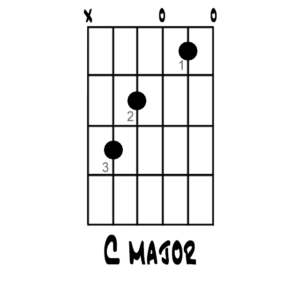If you are new to playing the guitar, you’ll need an extra few pointers on how to hold down your first chord. If you don’t have a guitar yet, you should take a look at our best acoustic guitars for beginners article before continuing.
First things first. For beginners, holding down a chord always seems a bit of a nightmare. Some of the strings won’t sound out properly, etc. But trust me a little practice and you’ll notice big changes.
Let’s look at how to fret a string.
Pluck one of the strings without putting a finger on the fretboard, you can hear it ring quite nicely. Now touch a string on the fretboard without pressing it hard enough to force it onto the surface of the fretboard. Now pluck it, the ringing tone has stopped and all you get is a dead sound when holding a chord this is generally what you want to avoid.
Now use one finger to hold down a string, on any fret (on the wooden part between two of the metal frets). You should use the very fingertip itself such that your finger is perpendicular to the fretboard, in other words coming straight out of the board. Try not to touch any neighboring strings with the finger. Now play that string and you should get the nice ringing tone again. Notice the difference that it has made. If your finger touches other strings whilst holding down a chord, it will produce the effect earlier encountered of deadening the tone (called muting), so be wary so as to not do this whilst playing chords (unless you intend to do that).
Now try a chord. C major would be a nice easy one to try as its notes are spaced such that your fingers shouldn’t interfere with each other. At first, when you try it, you’ll have a few dead sounding strings. If so locate these and see what fingers are touching them and try to move them so that they are still holding down the required note but not touching any other string. Not easy, but trust me you’ll soon get the hang of it.
What pressure should you apply to the string? The answer is quite simple for you to try and see. Hold a string down lightly and pluck it, does it ring? if so you may have it right. Try holding one harder, there shouldn’t be any difference apart from that your finger gets sore! So the answer is you need enough pressure for the note to sound, but using too much pressure will just give yourself a sore hand. Personally, I use more pressure than required to make the note sound, but not too much that I end up with a sore hand. So please yourself. One thing to bear in mind when you are first starting out is that your fingers will be quite soft, and as you practice your fingers are going to get sore. If you spend a lot of time on practice, at first they will get very sore. But after playing for a while, your fingertips will grow calluses (hard skin) which will help to solve this. These grow most effectively through regular practice. For instance, if don’t practice guitar for around 2 weeks they soften up a bit and I will notice my fingers being sore if I play for around an hour or two
So now I think you have enough information to hold down a chord properly! Give it a whirl.
Is the process the same on every guitar?
Well, no. For example, the bass guitar only has 4 strings most of the time, so learning to press the chords on them is a bit different. If you want to get started wit ha bass guitar, i would recommend you buy a bass guitar under $200 first, and see if it works out for you.


